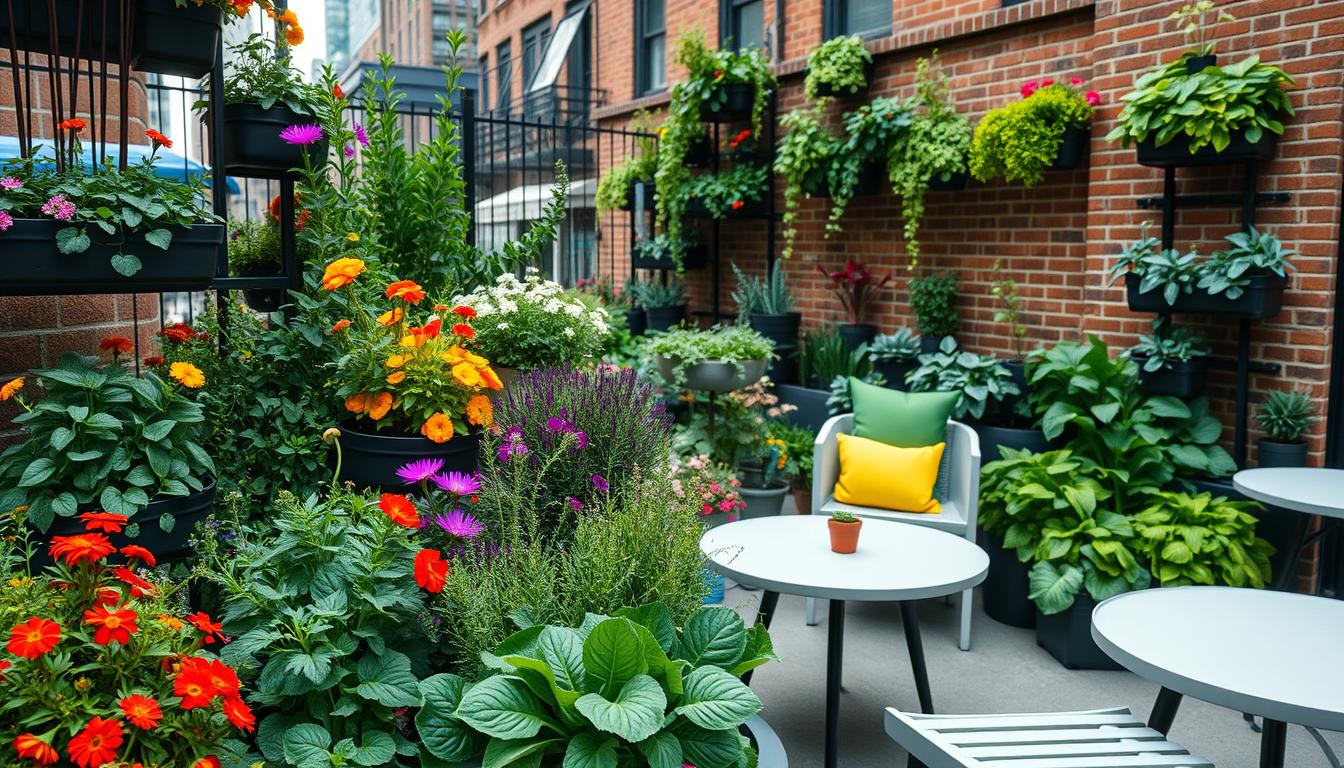I’m excited to share my top picks for the best plants for urban gardens. City gardening can be a challenge, but with the right choices, you can create a stunning green space. In this guide, I’ll walk you through a variety of plants that thrive in urban environments.
From compact veggies to colorful flowers, we’ll explore options that work well in small spaces. I’ll show you how to make the most of your balcony, patio, or tiny yard. With these city gardening plants, you’ll transform your urban space into a lush oasis.
Get ready to dig in and discover the perfect plants for your urban garden. Whether you’re a seasoned gardener or just starting out, I’ve got tips to help your city garden flourish. Let’s bring some green to the concrete jungle!
The Importance of Choosing the Right Plants
Choosing the right plants can change your living space. Small space gardening is about making smart choices. The right plants make your space look good and help the environment.
Enhancing Urban Spaces
Container gardening plants can make urban areas come alive. A few pots can turn a bare balcony into a green oasis. Even the smallest corner can become a garden with the right plants.
Supporting Local Biodiversity
Urban gardens help local wildlife. By picking native plants, I’ve seen more butterflies and birds. These gardens give homes to insects and small animals, making our cities healthier.
Improving Air Quality
Some plants clean the air, which is great in cities. I’ve added air-cleaning plants to my garden. This makes my home air cleaner and helps the whole neighborhood.
Choosing the right plants for small gardens is important. They make our spaces look better, help wildlife, and clean the air. The right plants can really change urban living.
Factors to Consider for Urban Gardens
Urban vegetable gardening is a rewarding hobby that brings nature to your doorstep. Success in city gardens depends on a few key factors. Let’s explore what you need to know to create a thriving green space in your urban environment.
Available Space and Light
Space is often at a premium in cities. Assess your area carefully. Balcony garden plants can thrive in small spaces with the right setup. Consider vertical gardening or hanging baskets to maximize your growing area.
Light is crucial for plant growth. Most vegetables need at least 6 hours of direct sunlight daily. If your space is shaded, opt for shade-tolerant herbs or leafy greens.
Climate and Weather Conditions
Understanding your local climate is vital for urban gardening success. Always check the hardiness zone for your area before selecting plants. This ensures they can withstand local temperature ranges.
Wind can be a challenge for balcony gardens. Use windbreaks or choose sturdy plants that can handle breezes.
Soil Quality and Maintenance
Good soil is the foundation of any garden. For container gardening, use a high-quality potting mix rich in organic matter. Regular fertilizing is essential as nutrients deplete quickly in small spaces.
Water your urban vegetable garden consistently. Ensure proper drainage to prevent root rot.
| Factor | Consideration | Solution |
|---|---|---|
| Space | Limited area | Vertical gardening, containers |
| Light | Varying sun exposure | Choose plants based on light needs |
| Climate | Urban heat islands | Select heat-tolerant varieties |
| Soil | Container limitations | Use high-quality potting mix |
Best Vegetables for Urban Gardens
Urban vegetable gardening is a rewarding way to grow fresh produce in limited spaces. I’ve found some great edible plants for cities that do well in small areas. Let’s look at the best vegetables for your urban garden.
Compact Varieties for Small Spaces
Space-saving veggies are perfect for urban gardens. Dwarf tomatoes, bush beans, and compact cucumbers grow well in containers or small plots. These plants produce a lot without taking up too much room.
Fast-Growing Options for Quick Harvests
For quick results, try fast-growing vegetables. Radishes, lettuce, and spinach are ready to harvest in just a few weeks. These speedy growers are great for impatient gardeners or those with short growing seasons.
| Vegetable | Days to Harvest | Growing Conditions |
|---|---|---|
| Radishes | 21-30 days | Full sun, well-drained soil |
| Lettuce | 30-45 days | Partial shade, moist soil |
| Spinach | 40-50 days | Cool weather, rich soil |
Nutrition and Flavor Benefits
Growing your own vegetables offers incredible nutrition and flavor advantages. Fresh-picked produce has more vitamins and minerals than store-bought options. Plus, homegrown veggies taste better because you can harvest them at peak ripeness.
Urban vegetable gardening lets you enjoy nutrient-rich, flavorful produce right from your backyard or balcony. By choosing the right edible plants for cities, you can create a thriving garden that fits your space and provides delicious, healthy meals.
Top Herbs to Grow in Urban Environments
Urban gardening is easy. You can grow herbs in small spaces. Herbs are great for city folks who want greenery and fresh tastes.
Culinary Uses of Fresh Herbs
Fresh herbs make meals special. I use basil in pasta sauces, cilantro in tacos, and mint in drinks. Growing your own saves money and cuts down on waste.
Container Gardening for Herbs
Container gardening is perfect for cities. You can use small pots on windowsills or balconies. I even grow herbs in old teapots and mason jars for a unique look.
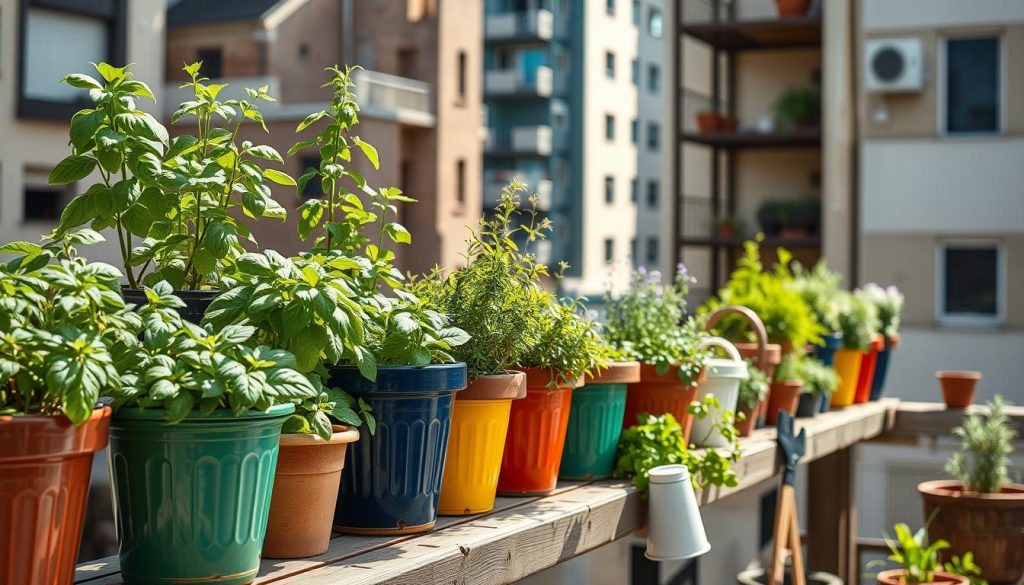
Low-Maintenance Herb Choices
Busy people need easy plants. My top picks include:
- Rosemary: Drought-resistant and fragrant
- Thyme: Compact and versatile
- Mint: Fast-growing and hardy
- Chives: Resilient and great for small spaces
These herbs need little care. They’re perfect for beginners or those with little time.
| Herb | Light Needs | Water Needs | Container Size |
|---|---|---|---|
| Basil | Full sun | Moderate | 6-inch pot |
| Rosemary | Full sun | Low | 8-inch pot |
| Mint | Partial shade | Moderate | 4-inch pot |
| Thyme | Full sun | Low | 4-inch pot |
Stunning Flowers for Urban Settings
Urban gardens can come alive with the right flowers. I’ve found some amazing plants for small spaces. Let’s find the best flowers for your balcony garden and make your urban oasis beautiful.
Perennials for Long-Term Beauty
Perennials are a smart choice for urban gardens. They come back every year, saving you time and money. Coneflowers, black-eyed susans, and lavender are great options. They add beauty to your space for years.
Annuals to Add Seasonal Color
Annuals are perfect for adding color to your garden. Petunias, marigolds, and zinnias do well in containers. They bloom all season, making small spaces lively.
Eco-Friendly Flower Choices
Eco-friendly flowers are key for sustainable gardening. Native plants like echinacea and rudbeckia help local pollinators and use less water. These plants are tough for city living and look great in containers.
| Flower Type | Examples | Benefits |
|---|---|---|
| Perennials | Coneflowers, Lavender | Long-lasting, Low maintenance |
| Annuals | Petunias, Marigolds | Vibrant colors, Season-long blooms |
| Eco-Friendly | Echinacea, Butterfly Weed | Pollinator-friendly, Drought-resistant |
Edible Plants That Thrive in Small Spaces
Urban gardening is now more exciting than ever! I’ve found incredible ways to grow edible plants in tiny spaces. It’s all about being creative and using every inch wisely.
Growing Fruits in Urban Gardens
You can grow fruits right in your city home. Dwarf fruit trees like lemons or figs do well in containers on balconies. Berry bushes, such as blueberries or strawberries, are great for small gardens. They’re small but produce lots of tasty fruits.
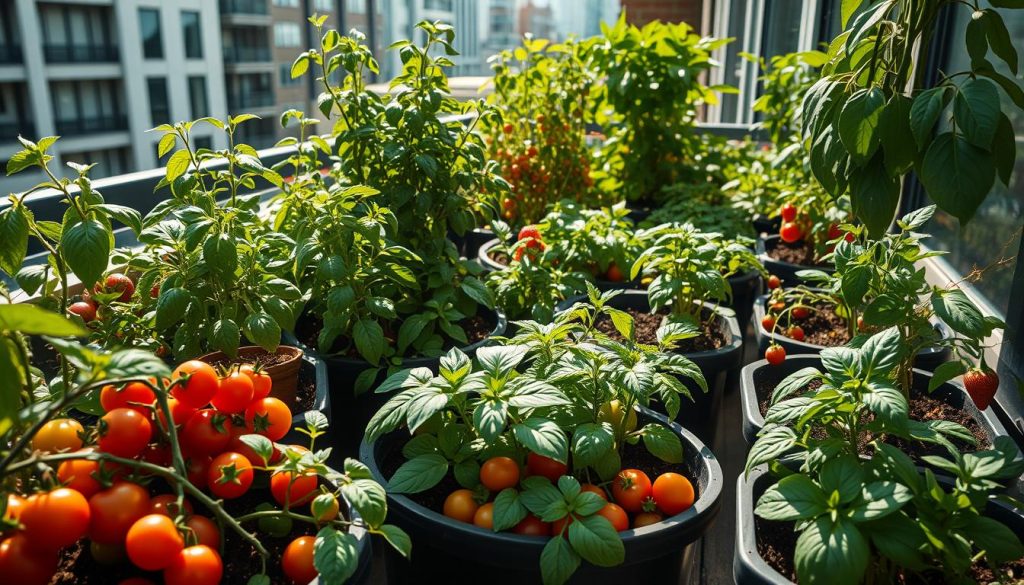
Vertical Gardening Ideas
Vertical gardening changes the game for small spaces. I love using trellises for climbing plants like peas or cucumbers. Hanging baskets are perfect for cherry tomatoes or herbs. Wall-mounted planters can hold many edible plants, making the most of small areas.
High-Yield Crops for Urban Spaces
Some plants are superstars in small gardens. Cherry tomatoes, bell peppers, and pole beans give big harvests in tiny areas. Leafy greens like lettuce and spinach grow fast and can be picked many times. These plants are ideal for urban gardeners wanting to get the most from their space.
- Cherry tomatoes: Compact and prolific
- Bell peppers: Versatile and space-efficient
- Pole beans: Vertical growth for high yields
- Leafy greens: Quick growing and multiple harvests
With these tips, you can turn any small urban space into a productive garden. It’s amazing how much food you can grow right in the city!
Best Indoor Plants for Urban Dwellers
Living in the city doesn’t mean you can’t enjoy greenery. I’ve found some amazing indoor plants that thrive in urban settings. These low-maintenance plants are perfect for busy city life and can transform your space into a lush oasis.
Air-Purifying Houseplants
Air quality is a big concern in cities. That’s why I love plants that clean the air. Spider plants, peace lilies, and snake plants are my top picks. They remove toxins and add fresh oxygen to your home.
Low-Light Tolerant Varieties
Not all urban homes get lots of sunlight. Don’t worry! There are plants that thrive in low light. I recommend pothos, ZZ plants, and Chinese evergreens. They’re tough and can handle dim corners with ease.
Stylish Indoor Planters
Your plants deserve beautiful homes too. I’ve seen some great planter options that fit any decor style. Hanging baskets for trailing plants, sleek ceramic pots for modern looks, or rustic terra cotta for a natural vibe all work well.
| Plant Type | Light Needs | Watering Frequency | Air-Purifying |
|---|---|---|---|
| Spider Plant | Indirect | Weekly | Yes |
| Pothos | Low to Bright | When soil is dry | Yes |
| Snake Plant | Low to Bright | Every 2-3 weeks | Yes |
| ZZ Plant | Low to Bright | Every 2-3 weeks | No |
These best plants for urban gardens are not just beautiful; they’re practical too. With minimal care, you can enjoy a green, vibrant home in the heart of the city.
Xeriscaping: Drought-Resistant Plants
Xeriscaping is a smart choice for city gardening plants. It uses drought-tolerant plants to create beautiful, low-maintenance gardens. I’ve seen how it can transform urban spaces.
Benefits of Xeriscaping in Urban Areas
In cities, xeriscaping has many benefits. It reduces water use, saving money and the environment. These gardens need less care, saving you time and effort. Plus, they look stunning all year.
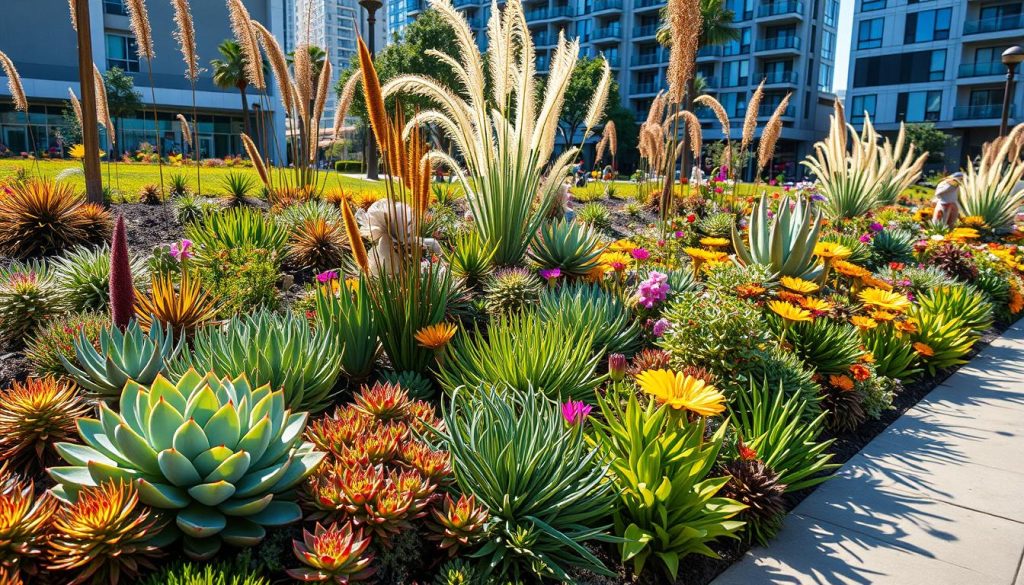
Native Plants for Low Water Needs
Native plants are key in xeriscape gardens. They’re adapted to local conditions and need little water. Some great choices include:
- Coneflowers
- Black-eyed Susans
- Ornamental grasses
These plants save water and support local wildlife.
Designing with Drought-Resistant Species
Creating a xeriscape garden is fun and rewarding. I love mixing different textures and colors of drought-tolerant plants. Group plants with similar water needs together.
Use rocks or mulch to retain moisture and add visual interest. With the right design, your xeriscape can be a real showstopper in the urban landscape.
Attracting Pollinators to Your Urban Garden
Urban gardens are key to supporting local ecosystems. By drawing in pollinators, you help create a lively space for plants and wildlife. Here are some tips to make your garden a haven for these vital creatures.
Selecting Flowering Plants for Bees
Bees are vital for many plants. To attract them, add these bee-friendly flowers to your garden:
- Lavender
- Sunflowers
- Bee balm
- Coneflowers
Plants that Attract Butterflies
Butterflies add beauty and life to gardens. To attract them, include these plants:
- Milkweed
- Zinnias
- Butterfly bush
- Marigolds
Creating a Pollinator-Friendly Environment
To make your garden pollinator-friendly, follow these steps:
- Avoid using pesticides
- Provide a water source, like a shallow dish with pebbles
- Plant in clusters to make it easier for pollinators to find flowers
- Choose native plants when possible
By using these plants and creating a welcoming space, you’ll attract many pollinators. This not only helps local ecosystems but also makes your garden more beautiful and productive.
| Plant Type | Best for | Container Size | Sun Requirement |
|---|---|---|---|
| Lavender | Bees | 12-16 inch pot | Full sun |
| Milkweed | Butterflies | 18-24 inch pot | Full to partial sun |
| Marigolds | Both | 6-8 inch pot | Full sun |
| Bee balm | Bees | 16-18 inch pot | Full to partial sun |
Seasonal Considerations for Urban Gardens
Urban vegetable gardening is fun all year round. I’ll show you how to plant for each season. This way, you’ll get the most from your balcony garden.
Cool-Season Vegetables and Flowers
Spring and fall are great for cool-season crops. Kale and spinach do well in these times. For color, try pansies or violas. They can handle a little frost and brighten your garden.
Warm-Season Planting Techniques
Summer is when warm-season plants shine. Tomatoes, peppers, and basil are perfect for this time. Use vertical gardening to save space. Trellises or hanging planters are great for cucumbers or pole beans.
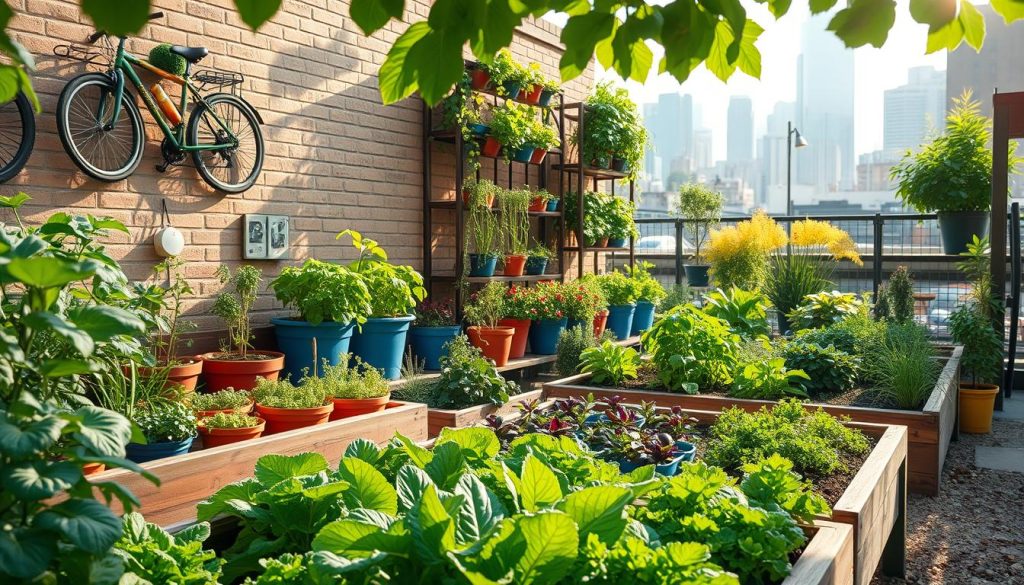
How to Extend the Growing Season
Don’t let short days stop your harvest. Use cold frames or row covers to protect plants. For balcony gardens, try moving containers. This lets you move plants to sunny spots or bring them inside when it’s cold.
| Season | Vegetables | Flowers | Techniques |
|---|---|---|---|
| Spring | Peas, Lettuce | Pansies | Cold frames |
| Summer | Tomatoes, Peppers | Marigolds | Vertical gardening |
| Fall | Kale, Carrots | Chrysanthemums | Row covers |
| Winter | Microgreens | Pansies | Indoor growing |
Sustainable Practices for Urban Gardening
Urban gardening is both rewarding and eco-friendly. I’ve found some great ways to make small space gardening sustainable. Let’s explore how to create a green oasis in the city while reducing our environmental impact.
Composting in Small Spaces
Even with limited room, you can turn kitchen scraps into nutrient-rich soil. I use a compact bin for my balcony. It’s perfect for small space gardening and keeps odors contained. Worm composting is another option that works well indoors. These methods reduce waste and provide free fertilizer for your plants.
Water Conservation Techniques
Saving water is crucial in urban gardens, especially when growing drought-tolerant plants. I’ve found that mulching helps retain moisture and reduces the need for frequent watering. Drip irrigation systems are excellent for delivering water directly to plant roots. You can also collect rainwater in barrels to use during dry spells.
Using Native Plants for Sustainability
Native plants are ideal for sustainable urban gardens. They’re adapted to local conditions and often require less water and care. I’ve filled my small space with native flowers and shrubs. They attract local wildlife and create a beautiful, low-maintenance garden. Plus, many native species are naturally drought-tolerant plants, perfect for water-wise gardening.
- Choose compact composting solutions
- Implement water-saving irrigation methods
- Select native, drought-resistant plants
- Create wildlife-friendly spaces
By adopting these practices, you’ll create a thriving urban garden that’s kind to the environment. It’s amazing how much impact we can have, even in the smallest of spaces!
Resources for Urban Gardeners
Growing plants in the city can be tough, but you’re not alone. I’ve found some great resources to help you succeed. Let’s explore where you can find support, inspiration, and the best plants for urban gardens.
Local Nurseries and Plant Shops
Your neighborhood nursery is a treasure trove of knowledge. These local experts can guide you to city gardening plants that thrive in your area. They often stock varieties suited for small spaces and tough urban conditions. Plus, you can see and touch the plants before buying!
Online Gardening Communities
The internet is buzzing with fellow urban gardeners eager to share tips. Websites like Reddit’s r/UrbanGardening and Facebook groups dedicated to city growing are goldmines of information. You can post questions, share your successes, and learn from others’ experiences with the best plants for urban gardens.
Educational Workshops and Events
Many cities offer gardening classes tailored to urban environments. Check out your local botanical garden or community center for workshops on container gardening, vertical growing, or choosing city-friendly plants. These hands-on experiences can really boost your green thumb skills and connect you with other plant lovers in your area.

